![]()
![]()
![]()
Group & Last Name Index to Full History:
A B C D E F G H I J K L M N O P Q R S T U V W X Y Z
Tracks are listed in chronological order by year, then alphabetically.
Listings do not reflect proper order by month or day: later oft precedes earlier.
Find on Page = F3. Not on this page? See history tree below.
Featured on this page loosely in order of first recording if not record release (as possible).
Names are alphabetical, not chronological, per year:
| 1901 | Antonio Chacón |
| 1910 | La Niña de los Peines |
| 1923 | Ramon Montoya |
| 1924 | Pepe Marchena |
| 1925 | Xavier Cugat |
| 1930 | Carmen Miranda Sabicas |
| 1941 | Carmen Amaya Antonio Mairena Carlos Montoya |
| 1945 | Franco Cerri |
| 1946 | Mario Escudero Bruno Martino |
| 1947 | Victoria de los Angeles |
| 1955 | Enrico Intra |
| 1956 | Tete Montoliu |
| 1960 | Lino Patruno Manitas de Plata |
| 1961 | Paco de Lucía |
| 1965 | Enrico Rava |
| 1966 | Paco Pena |
| 1967 | Enrique Morente |
| 1968 | Camarón de la Isla Manolo Sanlúcar |
|
Caveats in the employment of this page: 1. It descends in chronological
order by the year the artist or band is first found on a commercial record
issue (ideally) by year only, alphabetical thereat. One musician above
another doesn't necessarily translate to earlier issue unless the year
changed. 2. Though release dates are the aim with links to YouTube, some
are recording dates and may not be everywhere clearly distinguished. 3.
Reissues are used to represent originals without much discussion. |
||
|
This page addresses Latin recording in Europe. Being
dominated by flamenco in Spain, it is apt to commence with a few flamenco
references: Academic: *.
Copyrights: *.
Cultural: 1,
2.
Dance sites: 1,
2.
Encyclopedias: 1,
2,
3,
4,
5.
Flamenco sites: *.
Guitar sites: *.
Major artists: 1,
2.
Terms: 1,
2,
3,
4,
5.
Other: 1,
2,
3.
See also 'Flamenco' by Dennis Koster (Alfred Music Publishing 2002); 'Flamenco Guitar: Basic Techniques' by Juan Serrano (Mel Bay
Publications 1996/2016);
'The Keys to Flamenco Guitar' Vol I & II by Dennis Koster (Mel Bay
Publications 2015); 'A New Anthology of Falsetas for Flamenco Guitar' by
Paul Jared Newman (Bold Strummer 2009)
and 'The Politics of Flamenco: La leyenda del tiempo and ideology' by Jesús
López-Peláez Casellas 2017. Flamenco's roots
were in gypsy Andalusia, highly characteristic to itself with an emphasis on
maintaining integrity to tradition. Its origins were in dance with voice
added. Guitar's role in flamenco had for centuries been that of backup to
the main show otherwise, until such as Ramon Montoya
below. The folk music of
Andalusia that is flamenco came about through a mesh of gypsies, Jews, Moors
and the indigenous. The term "flamenco" appears in records by travelers in
Andalusia during the 18th century, quite a while before the emergence of the
cafe cantante in the mid 19th century via which flamenco began spreading to
increasing popularity. By
Montoya's time cantantes (singers) and dancers at cafes were
sharing stage with virtuosic tricks on guitar. As for
percussion, it consisted of clapping,
knocking and stamping via dance, flamenco's original element to which it is
distinctly bound, embroidery by guitar virtuosi developing upon that. In
addition to uniqueness to itself, as the folk music of Spain tradition is
flamenco's essence, also making it less readily given to fusing w other
genres. If
Latin rhythms on the other side of the Atlantic in the Caribbean (notably
percussion instruments) or South
America eagerly embraced
collaboration with jazz musicians in the States, flamenco has resisted
synthesis with other forms. Though
remarkable results in classical or jazz environments have occurred [: see Camarón de la Isla
and
Paco de Lucía with
John McLaughlin], flamenco
remains, as decidedly as necessarily, flamenco in and all of itself. As for Latin
Classical composers, they figure prominently in such as Italy throughout the
Classical section of these histories. Classical composition on the Iberian
Peninsula (such as Spain), however, didn't come to prominence until the latter 19th century
due largely to the centuries-long contest there between Christianity and Islam. |
||
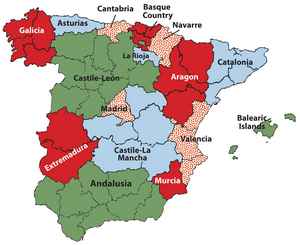 Andalusia Birthplace of Flamenco Map: lardbucket |
Flamenco
was and remains a distinct genre in and of itself, quite apart from classical or
jazz, though it fits comfortably under romantic. It had
its origins around 1850 with the emergence of the cafe cantata, arising out
of Andalusia, the southernmost region of Spain, the term
"flamenco" had come into usage in the latter 18th century. Uncertain in
origin, it is possibly derived from "gypsy," 'fire," "flame" and/or "fellah mengu," meaning "expelled peasant" in reference to the Moors. Flamenco's
heydays were around the turn of the century before recording could
disseminate it about the globe. It has since developed into numerous palos
(styles). The flamenco guitar is also constructed differently from the
classical guitar, having developed differently to its peculiar usage, such
as accompaniment to stamping baile flamenco (flamenco dance) or the cante
flamenco (flamenco singing). Later flamenco musicians would naturally associate with others in the classical or jazz
fields. But no matter how you fuse it, flamenco is fundamentally flamenco.
The first recordings made in Spain are thought as of late 1899 by Fred
Gaisberg, an American recording engineer said to have produced 128 tracks in
Madrid. There exists a discography published in 1900 listing among its
titles, 'Malaguenas' by Sr. Garcia, as well as several by Mochuelo: 'Soleares',
'Guajiras' and Malaguenas' among them. Those were among 64 tracks
played at a public gramophone demonstration costing 10 centimos to attend. A
magazine dated 1901 mentions cylinder recordings (invented 1889) by
Antonio Chacón. A quantity were made by El Mochuelo in 1901 as well, together with a
host of others having recorded by then. The first recorded discs appeared in
1901 or '02, one-sided and slightly over seven inches in diameter. Among
Spanish musicians found on such are El Canario Chico, El Mochuelo, La Rubia,
Niño de Cabra, Niño de la Hera and Sebastian Scottta (sic). As mentioned,
high-pitching singer,
Antonio Chacon, is thought to have
recorded on cylinder by 1901, those titles undetermined. Chacon
avoided recording for much of his earlier career, presumably finding it
pointless due to their poor audio quality, as did many other musicians of the
period. Born in 1869 in Jerez de la Frontera, Cadiz, Chacon is a leading
figure in the flamenco orthodoxy. He began
performing publicly in 1884, touring about Andalusia. Donald Clarke [Ref 3]
has him recording in 1909, 1913, 1925 and 1928. Among the better known
guitarists with whom he performed were
Ramon Montoya, later
Sabicas. Chacon
died in 1929 in Madrid. References: 1,
2,
3.
Catalogs: 1,
2,
3.
IMDb.
Compilations: 'Cátedra Del Cante' 1909/13/28 by Mivox 2006; 'Don Antonio Chacon' 3 CDs w book by Carlos Martín Ballester:
1,
2.
Archives: 'Nuevo Mundo' 1926.
Biblio: 'Seeking Silverio: The Birth of Flamenco'
by Paco Sevilla (Sevilla Press 2008):
1,
2.
Further reading: 1,
2,
3,
4,
5,
6,
7. Antonio Chacón 1922 Guitarra: Perico el del Lunar Note: 'Rosa si yo no te cogí' is a grenadina, that is, native to Granada in southern Spain about 75 miles northeast Malaga. Composer is undetermined. Antonio Chacón 1925 Guitarra: Ramon Montoya Note: 'Si preguntan por quién doblan' is a malaguena, that is, native to Malaga on the Mediterranean coast of southern Spain about 85 miles northeast of Gibralter. Composer is undetermined. Antonio Chacón 1928 Guitarra: Perico el del Lunar Note: 'Los Campanilleros' is a siguiriyas [1, 2, 3, 4], developing from out the tona, an original flamenco approach thought to have its origins in the region between Seville and Cadiz on the southwest coast of Spain about 75 miles northwest of Gibralter. The composer is thought to be Niño Ricardo. See also the campanilleros form: 1, 2, 3.
|
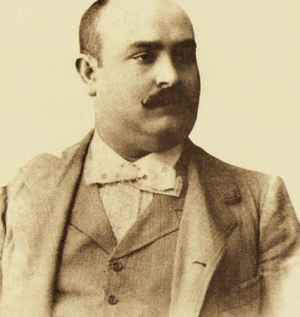 Antonio Chacón Source: Fernando Barros |
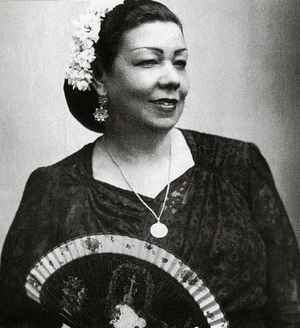 La Niña de los Peines Source: America Pink |
La Niña de los Peines (The
Girl of the Combs) was born Pastora Pavón Cruz in 1890 in Seville, Spain.
Never learning to read nor write, nor learning to sign her name until an
adult, La Niña de los Peines began performing at the theatre, Taberna de
Ceferino in Seville, toward supporting her family. She picked up the name,
the Girl of the Combs, due to a tango she often sang as to her combs made of
cinnamon. After touring Spain a bit
she made her initial recordings in 1909. She married flamenco singer, Pepe
Pinto, in 1931, 1933 or 1936 depending on the source. She issued about 355
records recorded into 1950. Having assumed her last theatrical role in 1949,
she then retired, with the exception of a brief performance in Cardoba in
1961, until her death on 26 November 1969, twenty days after the death of
her husband, Pepe. References:
1,
2,
3,
4.
Catalogs: 1,
2,
3,
4,
5,
6.
IMDb.
Compilations: 'La Niña de los Peines: Heritage of Andalusia' 1910-50 by the
Andalusian Center of Flamenco (258 recordings on 13 CDs)
1,
2.
IA.
HMR Project. La Niña de los Peines 1910 With guitarist, Ramon Montoya: Note: 'Acabara De Una Vez' is a cartagenera, that is, native to Cartagena on the Mediterranean coast about 250 miles northeast of Gibralter. It is a palo of the fandango family, the latter arising in the early 18th century as a dance for couples to eventually become a favorite among the aristocracy. La Niña de los Peines 1929 'Solomon to Be So Wise' Guitar: Manolo de Badajoz Tiento (fantasia) La Niña de los Peines 1932 Guitarra: Nino Ricardo La Niña de los Peines 1946 La Niña de los Peines 1949 With Pepe Pinto Composition: 1882: Quirino Mendoza y Cortés La Niña de los Peines 1961 Guitarra: Pepe Martinez Note: The buleria [1, 2] is a style of cante (singing) developed out the more basic form of flamenco, the solea [1, 2], the latter probably originating in the Cadiz-Seville region.
|
|
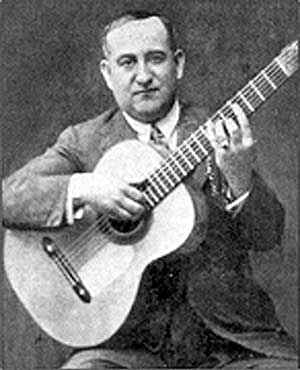 Ramon Montoya Source: Shine Music School |
Born in Madrid in 1879, flamenco
guitarist, Ramon Montoya,
is credited w originating the quivering note in flamenco guitar that is
called tremolo. Montoya happened along at just the right place and time when
flamenco dancers (it's element) and singers (added) began sharing stage w
guitar virtuosi, making percussion, voice and guitar the primary elements of
flamenco, which needn't come w anything else but emotive skirts and castanets. Which appears deceptively
simple since flamenco also comes w a myriad of forms and styles (palos) that will give you a
complex if you need a spare [but to begin: 1,
2,
3]. Montoya also made some of flamenco's earliest recordings as of 1909. Montoya didn't make
flamenco guitar famous, but he prepared the path for his nephew,
Carlos Montoya, who would.
The large portion of Ramon's career was spent backing flamenco performers
such as
La Niña de los Peines
[sessions 1909/11].
Montoya made no solo recordings issued in his own name until 1936, age 56, in Paris [Ref 2/ 1,
2,
3,
4].
Those were reissued [Discogs] in Spain in 1971 on 'Arte Clasico Flamenco' (Hispavox HAZS 270-01),
and in France on 'Génie de la Guitare Flamenca' (BAM LD 5430). The outbreak
of the Civil War in Spain in 1936 saw him leaving for Buenos Aires,
Argentina, (after Paris) where he began to tour South America w a couple
other much younger flamenco masters also in flight from the War,
Carmen Amaya and
Sabicas. But he, being above
fifty years of age at the time, wouldn't arrive to
the same level of international renown as they before dying in Madrid on 20 June 1949. Numerous recordings on which
Montoya features
solo were made available
in 1999
on the CD, 'Ramon Montoya: El Genio de la Guitarra Flamenca - Grabaciones Historicas 1923-1936' (Sonifolk 20130). See also
IA.
References: 1,
2,
3,
4,
5.
Catalogs: 1,
2,
3,
4.
IMDb.
Interviews: 'La Nación' 1937.
IA.
Discussion.
Other profiles: 1,
2,
3,
4,
5. More Montoya per 1924 under
Pepe Marchena. Ramon Montoya 1923-36 Composition: Francisco Tarrega Composition: Traditional Note: Dates of the above are undetermined. 'Alborado' is the first track on the 1999 compilation: 'El Genio de la Guitarra Flamenca - Grabaciones Historicas 1923-1936' (Sonifolk 20130). Ramon Montoya 1924 'I Won't Be Back Alive' With Nino de Marchena (Pepe Marhena) Composition: Mario Fernández Porta Ramon Montoya 1925 With Antonio Chacón Composition: Traditional Ramon Montoya 1928 With Aurelio Selles Note: 'Y el agüita no la aminoró' ('El agua no la aminoro') is an alegria(s) [*,], a form of palo originating in Cadiz. Ramon Montoya 1936 Composition: Montoya? Note: 'Solea' is a solea [1, 2], a form of palo originating in Cadiz-Seville region. The above title is the initial track on 'Arte Clasico Flamenco' (Hispavox HAZS 270-01) and 'Génie de la Guitare Flamenca' (BAM LD 5430).
|
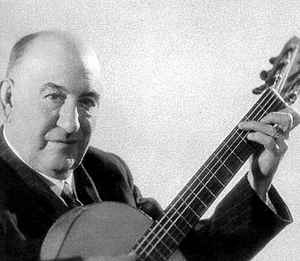 Ramon Montoya Source: Flamenco Guitars |
| Born José Tejada Marín in
Marchena, Seville, in 1903, flamenco vocalist,
Pepe Marchena (aka El Nino Marchena), sang in taverns as a
boy. He performed as Niño de Marchena during the earlier days of his career. As
he became more professional he began touring the cafes and theatres of
Andalusia. Arriving in Madrid in 1921, the next year he bagged employment at Teatro La Latina. Paid 200 pesetas daily, he must have been a valued
performer, earning more than the going rate. Sources state that Marchena
first recorded in 1922 but we can find no documentation of such. 1922
nevertheless saw him performing for the King and Queen of Italy upon their
visit to the Kingdom of Spain that June. His earliest determinable
recordings were in 1924, per the sixteen-volume release of 'Niño De
Marchena: Obra Completa en 78 rpm 1924-1946'. The twenties and thirties were spent
touring Spain, filling roles in opera flamenco in the twenties, moving
onward to films in the thirties. Marchena had become enormously popular by
the time of the
Spanish Civil War (1936-39). Reflecting that, he dressed too well for the
period, getting arrested by Republicans for being wealthy, albeit his
release was arranged by the Minister of the Frente Popular. Marchena
continued in opera, flamenco and films (such as 'La Dolores' and 'Martingala')
after the war with high success. The fifties saw Marchena touring South
America, Paris, Morocco and Algieria. He took flamenco as far away as
Pakistan in 1961. Marchena passed away on 4 December of 1986 in Seville.
References: 1,
2,
3,
4.
Catalogs: 1,
2,
3,
4.
IMDb.
IA. Further reading:
Alexandre D'Averc. Niño de Marchena 1924 Guitar: Ramón Montoya Note: 'A Ningún Hombre Quería' is a palo of the fandango family, the latter arising in the early 18th century as a dance for couples to eventually become a favorite among the aristocracy. Guitar: Ramón Montoya Note: 'Lucero de la Mañana' is a fandango de Huelva [1, 2] originating in Huelva off the Spanish coast about 35 miles from the Portuguese border. Guitar: Ramón Montoya Niño de Marchena 1925 Guitar: Manuel Bonet Guitar: Manuel Bonet Niño de Marchena 1929 Likely recorded in 1929 Niño de Marchena 1930 Guitar: Ramon Montoya Pepe Marchena 1935 Granaina de la película Paloma de mis amores Guitar: Ramon Montoya Note: The above title is a granaina [1, 2, 3], meaning a fandango originating in Granada about 55 miles northeast of Malaga by air. Pepe Marchena 1955 Composition: Hermanos Álvarez Quintero José Serrano Film: 'La Reina Mora' Film: 'La Reina Mora'
|
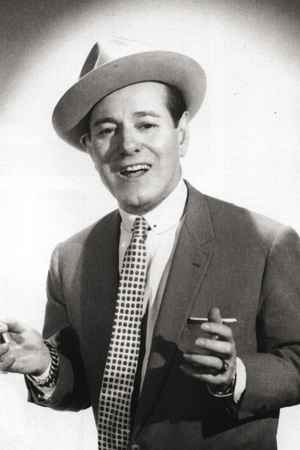 Pepe Marchena Source: La Flamenca |
|
|
Xavier Cugat See
Xavier Cugat. |
||
|
Carmen Miranda See
Carmen Miranda. |
||
|
|
Traditional flamenco had emphasized song and dance over
instruments, relegating guitar to a supporting role. That was changed by
Ramon Montoya (1879-1949), a major name in the history of flamenco who yet
did little recording on his own. It was with
Montoya that flamenco
guitar began to be appreciated in itself, solos performed without lyric or
stamping heels. One rare example of
Montoya performing solo is this
solea flamenco
from 1936. Though
Montoya
toured across the Atlantic he didn't arrive to
the international renown that guitarist and oft younger partner (by 32
years),
Sabicas, would, his a mastery that Chet Atkins, another
world-class guitarist, thought to be the finest on the globe. Born Agustín Castellón Campos in 1912 in Pamplona, Spain, Sabicas began guitar at
age four, performing publicly two years later. But Sabicas is another of
those musicians concerning whom sources vary widely. He is also said to have
given his first performance in Madrid at age nine. Howsoever, he is known to
have gone by El Niño de las Habicas early in his career, called Habicas as a
child by his mother due to his liking of broad beans. Sabicas' first recordings are given as 1930 only
tentatively. Sources range his first recordings from the latter twenties in
Barcelona to the thirties to 1942 with flamenco
singer, Anita Sevilla. We give 1930 due an import issued in 1993 by
Fonografica Del Sur, claiming a
compilation from 1930 to 1940. The title of that release is 'Sabicas –
Recital de guitarra flamenca Vol 1', the first of three. Other sources,
however, doubt the authenticity of that collection. Be as may, upon the outbreak of the Spanish Civil
War in 1936 Sabicas left Spain for South America w
Carmen Amaya. Touring
eventually led to Mexico City where he supported
Amaya's
dancing career, including a trip to New York City in 1941 to perform at
Carnegie Hall. The early forties in Mexico also brought marriage to Esperanza González Erazo. Wikipedia has three of
his four children - Maricruz (b '44), Carlos (b '46 deceased), Agustine (b
'52) and Margaret (b '56) - yet living as of this writing. It was 1949 when
Sabicas' album, 'Flamencan Guitar
Solos', was issued in the U.S. on Decca CU 709. Later moving to New York
City in the fifties, he returned to Spain in 1967. As a virtuoso Sabicas
made a major contribution to the international renown of flamenco. He died of pneumonia in a Manhattan hospital upon multiple strokes on
14 April 1990. References: 1,
2,
3,
4,
5,
6,
7,
8.
Catalogs: 1,
2,
3,
4,
5.
IMDb.
IA.
Sheet music: 'Aires de Puerto Real' by Sabicas *;
'Embrujo de Huelva' by Sabicas *;
'Sabicas 1912' by Oscar Herrero *.
Further reading: Alberto Reyes;
RYM.
Per 1945 below,
later sources credit Sabicas with an uncredited appearance in the film, 'Los Amores de un
Torero'. Sabicas 1939 Film: 'Martingala' Soundtrack: Juan Álvarez García Note: 'Grenadinas' may be a folk traditional first arranged for guitar by Andres Segovia. The title indicates authorship in the region of Granada, Spain, if not Granada. Sabicas 1942 With Anita Sevilla 1: 'El Sentío' 2: 'Que Tu Me Quieres Yo lo Se' 3: 'Que le Mande a Decir' 4: 'Las Cristianas Note: 2011 compilation: 'Cantes, Cantos y Músicas de la Segunda República Española'.Sabicas 1945? Film: 'Los Amores de un Torero' Dance & vocal: Carmen Amaya Soundtrack: Antonio Díaz Conde Note: The above is identified as a colombiana, meaning of Columbian, not Spanish, origin. Sabicas 1957 With Carmen Amaya Music: Carlos Montbrun Ocampo Lyrics: Osvaldo Rocha Composition: Carlos Montbrun Ocampo Hernán Videla Flores Note: Both of the above are identified as bularias [1, 2] and cuecas [1, 2, 3], The bularia is a fast-temoo style originating in Jerez, Spain, applied in the above to cuentas, meaning of origin in the region where Argentina, Bolivia and Chile all share common borders. The cueca is the national dance of Chile. Sabicas 1959 Duet with Mario Escudero Composition: Sabicas/Escudero Carlos Montbrun Ocampo With Dolores Vargas Composition: Sabicas/Escudero Album Composition: Antonio Quintero Ramírez Manuel López-Quiroga Rafael de León y Arias de Saavedra Album: 'The Fabulous Sabicas' Sabicas 1960 Album All comps by Sabicas Sabicas 1963 Composition:Ernesto Lecuona (Cuban) Sabicas 1972 Television broadcast Note: The rondena is a palo (form) of flamenco originating in Ronda, Malaga, forty or so miles west of Malaga for birds. The alegrias is a form of flamenco originating in Cadiz which developed alongside the basic solea (plural: solearas) [1, 2] perhaps originating in Seville, otherwise the Cadiz-Seville region. 1: 'Duquelas de Triana' 2: 'Mi Solea' 3: 'Embruyo Sevillano' Television broadcast All comps by Sabicas Sabicas 1986 Television broadcast Sabicas 1988 Filmed concert
|
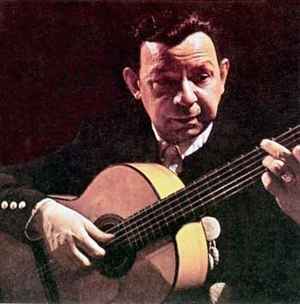 Sabicas Source: grapewrath |
|
Aldo Romano See
Aldo Romano. |
||
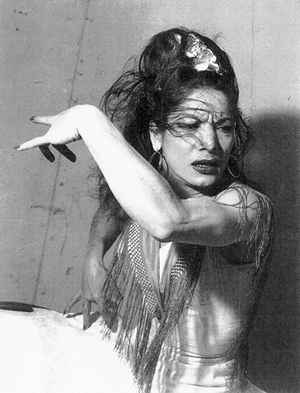 Carmen Amaya Source: Gypsy Heart
|
Flamenco dancer (bailaora),
Carmen Amaya, joins
Sabicas in the
distinction of taking flamenco international, making it famous on both sides
of the Atlantic. Born with a passion in 1918 in
Barcelona, there was a cave near Granada where she liked to dance as a child.
She later danced with her father on guitar in waterfront bars in Barcelona,
appearing at the Bar de Maquet at age ten. Amaya was a vocalist, though that hardly at all in comparison to gypsy dance
for which she's a major figure in Spain's cultural history. Amaya is thought
to have appeared in film at age 16 in the 1929 production of 'La Bodega'
('The Winery'). After appearing in 'La Hija de Juan Simón' (1935) she filled
a starring role in 'Maria de la O' as Maria de la O in 1936. Filmographies
indicate that wasn't released in Spain until 1939, following the three-year
Spanish Civil War that began on 18 July of '36 and ceased on 1 April 1939
(resulting in the Nationalist dictator, Francisco Franco, assuming his
position as Caudillo [Head of State]). 'Maria de la O' didn't premiere in the
United States until 1942, eight years after filming. Upon the outbreak of
the Civil War Amaya had headed for Buenos Aires, Argentina, with Sabicas, also joining much older
Ramon Montoya there who
had arrived from Paris. Touring in South America led to Mexico City where
her career in dance was supported by Sabicas, they eventually taking a trip
to New York City in 1941 to play Carnegie Hall [numerous sources though not
listed at the CH timeline].
DAHR finds her in sessions in New York on 1 & 4 of June toward releases like
'Tondero (Decca 23227)', 'La Tana' (Decca 23227), 'Corazone de Acero' (Decca
23228) and 'Fiesta Jerenzana' (Decca 23228). Those were family recordings on
which she was joined by Jose Amaya (El Chino - father), Leonor Amaya
(sister), Paco Amaya (brother) and Antonio Amaya (unidentified). Flamenco Girls has her getting deported from the United States to Cuba after
that, where she appeared in the short
film, 'El Embrajo del Fandango', in 1941. In 1944 she returned to the States
to perform for Franklin Roosevelt at the White
House. Amaya returned to Spain in 1947 (Franco declaring Spain a monarchy
that year). By that time she was commanding $2,000 a week in NYC, $14,000 in
Rio de Janeiro. Marrying the guitarist, Juan Antonio Agüero, in 1951, she visited the White House again
to dance for Harry Truman in 1953. Though compilations abound, Amaya did
very little recording. Among her albums were 'Flamencan Songs and Dances'
(1950), 'Flamenco!' with Sabicas (1958) and her final, 'Furia!' (1965
posthumous). Her last film was 'Los Tarantos', which release (1964) she
didn't live to see, dying in Barcelona of kidney failure on 19 November 1963.
References: 1,
2,
3,
4,
5,
6,
7,
8,
9,
10.
Sessions: DAHR (1941 NY).
Catalogs: 1,
2,
3,
4.
IMDb.
Documentaries: 'Queen of the Gypsies' by Jocelyn Ajami.
IA.
Biblio: 'Carmen Amaya'
by Montse Madridejos & David Pérez Merinero (Edicions Bellaterra 2013); 'Queen of the Gypsies' by Paco Sevilla (Sevilla Pr 1999).
Further reading: Flamenco Papers;
Montse Madridejos; Núria Martorell. Per 1961 and 1963
below, the bularia(s) is a fast-tempo flamenco form originating in Jerez. Carmen Amaya 1929 Film: 'La Bodega' ('The Winery') Carmen Amaya 1935 Film: 'La Hija de Juan Simón' Carmen Amaya 1936 Film: 'Maria de la O' Note: In the film above Carmen dances multiple sevillanas [1, 2, 3], a common form of flamenco springing from Seville. She finishes w a solea, a form originating in the Cadiz-Seville region. Carmen Amaya 1938/45 'The Bewitching Fandango' Composition:José María Palomo Note: The above is two versions of 'Embrujo del Fandango' w 1938 following 1945. The first (1945) is from the film, 'Los Amores de un Torero'.The second (1938) is from the film, 'Passion Gitana'. Carmen Amaya 1954 Film: 'Dringue, Castrito y la Lámpara de Aladino' Note: The zambra [1, 2, 3, 4], from Arabic "zumra" meaning "party", is a style of flamenco dance that had once been common at weddings. A zambra gitano indicates origination in Gitano, a quarter of Granada. The fusion of flamenco w the Arabic belly dance is more properly called the zambra mora. Carmen Amaya 1941 'The Bewitching Fandango' Composition:José María Palomo Film: 'Original Gypsy Dances' Carmen Amaya 1958 Film: 'Musica en la noche' Note: The Alegrias [1, 2] is a form of flamenco originating in Cadiz. "Allegria" translates to "joy" in English. Carmen Amaya 1961 Film Carmen Amaya 1962 Album: 'Cantos y Bailes Flamencos' Carmen Amaya 1963 Film: 'Los Tarantos' Carmen Amaya 1964 Album: '¡Inolvidable Carmen Amaya!' Brunswick EPB 10741 Recorded in New York Guitar: Sabicas Both comps by Amaya/Sabicas Note: The garrotin [1, 2, 3, 4] is a form of flamenco generally credited to Ramon Montoya, made famous by El Faico who combined it with dance in Madrid. Montoya derived the garrotin from out of the flamenca tango (which may or may not be related to the Argetine tango). That is disputed, however, by two schools of thought that would place its conception, not in Andalusia, but northern Spain. The one has gorrotin birthed in the Asturias-Galicia region in northwest Spain off the Atlantic, arriving to Andalusia by sea (past Portugal) at Cadiz on the Mediterranean (short of Gibralter eighty some miles). Another theory has garrotin developed by Catalan gypsies in northeast Spain. Relevantly, though the flamenca tango may or may not be related to the Argentine tango, one style of flamenco does share roots w dance across the Atlantic, the rumba flamenca, conceived from the Cuban guaracha.
|
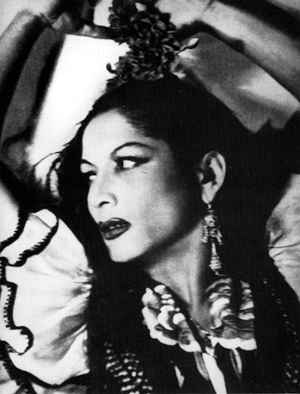 Carmen Amaya Source: Carlos Olalla |
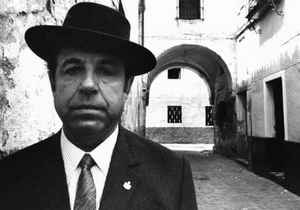 Antonio Mairena Source: Iniciacion al Flamenco |
Born Antonio Cruz García in
Mairena del Alcor, Seville, in 1907,
flamenco singer,
Antonio Mairena, was as a vocalist
who emphasized traditional gypsy flamenco, a purist who didn't participate
in such as opera flamenco. Nor did he care to subject song to flamenco
dance,
Carmen Amaya is said to be the only dancer with whom he liked to sing. In 1941 Mairena recorded his first batch of eight bulerias and fandangos with guitarist, Esteban Sanlúcar, at the Studio of La Voz de Su Amo
in Barcelona. 'Disco Tangier' appeared in 1944. He didn't enter the studio
again until 1950, recording another batch of eight for Columbia in Madrid.
During the early fifties Mairena joined a dance company run by one, Antonio,
with which he toured in America, Europe and Asia for the next decade. 'Disco
London' appeared in 1954. The sixties brought his book co-authored w Ricardo
Molina, 'Mundo y Formas del Cante Flamenco' (Revista de Occidente/ Madrid
1963). His autobiography, 'Las Confesiones de Antonio Mairena' (U of Seville
1976), was assisted by poet, Alberto García Ulecia. As Mairena's health began to wane in the seventies
so did his career. He died in September of 1983. Mairena's great draw for
some was his integrity per the earliest flamenco which, however, made him
unpopular with others, finding him reactionary and rigid. References:
Ambiente;
Andalucia: 1,
2,
3;
Biografias y Vidas;
Wikipedia.
Catalogs: 1,
2,
3,
4 (w lyrics),
5,
6.
Compilations: 1945-83.
IMDb.
IA.
Further reading: José Manuel Navarro. Antonio Mairena 1941 ('The Keys of Tetuan') Album: 'Fiesta por bulerías y fandangos' Antonio Mairena 1954 From 'Disco de Londres' Guitarra: Manuel Morao Palo: Martinete Palo: Tiento Antonio Mairena 1964 Palo: Fandango Guitarra: Melchor de Marchena Antonio Mairena 1965 Antonio Mairena 1966 Palo: Solea Album: 'La gran historia del cante gitano-andaluz' Guitarra: Niño Ricardo Antonio Mairena 1972 Guitarra: Melchor de Marchena Antonio Mairena 1976 Palo: Siguiriyas LP: 'Esquema histórico del cante por siguiriyas y soleares' All comps by Mairena Antonio Mairena 1979 Guitar: Enrique de Melchor Antonio Mairena 1981 Guitar: Juan Habichuela See Claude Worms Antonio Mairena 1983 From 'El calor de mis recuerdos' Guitars: Enrique de Melchor & Pedro Pena Palo: Solea See Andrés Raya
|
|
| Born in Madrid in 1903, flamenco
guitarist,
Carlos Montoya, was nephew to
Ramon Montoya. He began playing
flamenco guitar in cafes at about age fourteen. Montoya probably wasn't
presuming the international fame to which he would arrive when he joined his
first dancing troupe in 1928, run by Antonia Merce with dancer, La
Argentina. Moving onward to other companies after three years with Merce,
Montoya first saw the United States with dancer, La Teresina, in the mid
thirties, the Far East as well. In 1938 in Germany (during the Spanish Civil
War 1936-39) he performed guitar in the film,
'Carmen, la de Triana' (starring Imperio Argentina), alongside his uncle,
Ramon. He also began working with dancer, La Argentinita (Encarnacion Lopez)
in 1938 and would work with her until her death in 1945. World War II saw Montoya
move his base of operations to the United States, eventually to become a
citizen. He also married American dancer, Sally MacLean, in 1940, the couple
to settle in Manhattan. On 2 Oct 1940 he recorded a suite of solos for Decca under his own name: 'Bulerias'
(18103), 'Fandanguillos' (18103), 'Alegrias' (18104),
'Farrucia' (18104), 'Solea Rosa' (18105) and 'Sevillanas' (18105). In 1946 Montoya recorded several titles with his
Argentinians: 'Cafe Chinitas', 'Tango Del Negrito', 'Malaguena', 'Variociones
Por Bulerias', 'Zambrilla' and 'Folias Canarias'. Among his more than 40
albums was 'Guitar Recital' issued on Period Records RL 1928 in 1958.
Flamenco met jazz on 3 November of '58 when Montoya recorded 'From St. Louis
to Seville' in NYC backed by musicians,
Barry Galbraith (guitar),
Milt Hinton (bass) and
Osie Johnson (drums). He went
down live at a solo concert given in Town Hall in NYC on 24 Feb 1962 toward
'The Incredible Carlos Montoya'. Montoya was of major
significance to flamenco for a number of reasons beyond his virtuosic skill.
He was instrumental in bringing forth flamenco guitar for its own sake,
minus its traditional dancing and singing. He also brought flamenco guitar
into collaboration with, not only orchestra, but symphony. He meanwhile took
flamenco guitar throughout the world, touring so extensively that at one
point in the seventies (he in his seventies as well) he was delivering three
concerts a day for a total of 390 performances in 1979. Montoya died on Long Island (Wainscott), New York, on 3
March 1993 [obits: 1,
2]. His niece is California flamenco dancer,
Rosa Montoya.
References: 1,
2,
3,
4.
Catalogs:
1,
2,
3,
4,
5.
Compilations: 'From St. Louis to Seville' on Blue Moon BMCD 852.
Further reading: Jason Webster.
Other profiles: *.
Per 1938 below, Montoya appears with his uncle,
Ramon, neither featured, in the
1938 film, 'Carmen, de la Triana', directed by Florian Rey in Germany. Carlos Montoya 1938 Film: 'Carmen de la Triana' Vocal: Imperio Argentina Carlos Montoya 1949 Album Carlos Montoya 1953 Vocal: Lydia Ibarrondo Composition: Francisco Infantes Florido Luis Rivas Carlos Montoya 1954 With José Moreno Carlos Montoya 1956 Composition: Carlos Montoya Carlos Montoya 1957 Filmed live Carlos Montoya 1958 Album: 'Recital di Chitarra Spagnola' Composition: WC Handy Carlos Montoya 1959 Film Carlos Montoya 1961 Carlos Montoya 1962
|
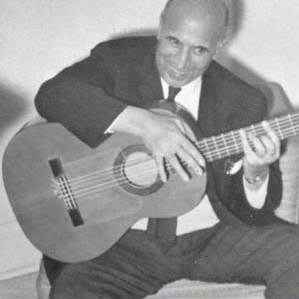 Carlos Montoya Source: Unique Guitar |
|
|
Franco Cerri See
Franco Cerri. |
||
| Born Mario Escudero Valero
Jiménez Valverde in
Alicante, Spain, in 1928, flamenco guitarist,
Mario Escudero,
also went by El Niño De Alicante. He studied both classical and
flamenco guitar as a youth. His debut performance is thought to have been at
the Teatro Español in Madrid in 1944. In 1946 (age 18) he appeared on a
couple recordings by singer, Estrellita Castro: 'Sevillanas de la Moda' and
'Er Yeli'. He issued 'Viva Flamenco' in 1950 on Decca DL 8736
[1,
2]. In July of 1952 he recorded the album,
'El Pili Flamenco', with
guitarist,
Alberto Velez. His album, 'Fiesta Flamenca', was recorded in 1954 for MGM,
released the next year. Also issued in '55 were his LPs, 'Mario Escudero and
His Flamenco Guitar' and 'Flamenco'. His initial of several albums recorded
as El Niño de Alicante is thought to be 'Flamenco Festival' in 1957
(qualified in that no dates are identidied for 'Viva el
Flamenco' Musicdisc CV 957). The first of at least four albums on which Escudero appeared
with
Sabicas is thought to be as of 1958 for Elektra: 'Festival Gitana'.
Escudero eventually toured Europe, South America and the US. He became a
United States citizen in 1969, coming to
reside in both New York City and Spain. He settled for Sevilla in the early
eighties, commuting to the States for concerts and recordings. He returned
to the States in 1994, pursuing treatment for Alzheimer’s disease in Miami,
where he died ten years later on 19 Nov 2004, suffering with Parkinson's disease.
References: 1,
2,
3,
4,
5.
Discos: 1,
2.
Discussion.
Further reading: Da Flamenco.
Biblio: transcriptions: 'The Glory of the Flamenco Guitar'
by
Claude Worms. Mario Escudero 1946 With Estrellita Castro Compositions: Kola/Castellanos Mario Escudero 1952 With Alberto Velez Composition: Escudero/Valez Mario Escudero 1955 From 'Flamenco' Composition: Niño Ricardo/Jose Luis de la Paz From 'Mario Escudero and His Flamenco Guitar' Composition: Escudero/Ángel Ortiz de Villajos Composition: Francisco Merenciano Bosch/Escudero Mario Escudero 1959 From 'Spanish Dances' Mario Escudero 1990 Filmed live
|
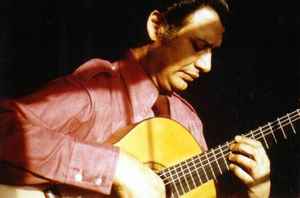 Mario Escudero Source: Discogs |
|
|
Born in 1925 in Rome, one nigh wouldn't know that
jazz/popular vocalist,
Bruno Martino [*], existed per the
internet excepting Italian Wikipedia (English). But at YouTube he's not all that obscure. He began his career in
clubs and radio in 1944. Lord's disco has him recording titles as early as
three sessions in May and August of 1946 in Milan with a quintet led by
Leonardo Principe: 'Blue Skies', 'It Had to Be You', 'I Got Rhythm', 'Moonglow'
and 'Stompin' at the Savoy (Odeon issue numbers: TW3211, TW3225 and TW3289). He toured Europe, formed an orchestra, did a bit of
composing for French singer,
Caterina Valente, and began
singing when his vocalist didn't show up for an engagement. What is thought
his first release was in 1958: 'Come Prima' bw 'Perry Como Sorride E Fa',
those on HMV. Martino released three EPs of four titles the next year:
'Bruno Martino Music', 'Sanremo -59' and 'Italian Holiday Memories'. He also
released the album, 'I Grandi Successi Di Bruno Martino', in '59. Martino
was known as Principe dei Nights (Prince of the Nightclubs). Discogs shows
him good for sixteen albums, not likely his full catalogue, until the last in 1991: 'Lasciamo Che Sia Il
Tempo'. He died in Rome on June 12, 2000, of heart attack [Wikipedia] so
something doesn't wholly jive with Tom Lord's date of 7 Feb 2001 in Milan
for 'Per Bruno Martino' (Philology W202-2) on which he contributes voice to
'Arrivederci' performed by the Renato Sellani Trio which also records other
compositions by Martino on that album like 'Estate' ('Summer'), an earlier
version by Martino apparently included. That is, tracks on which Martino
appears had to have been recorded prior to 12 June 2000.
See also 1,
2.
Other profiles: 1,
2.
Discos: 1,
2,
3,
4,
5.
IMDb.
Bruno Martino 1958 Composition: Francesco Pisano Bruno Martino 1959 Composition: Roman Vatro/Carol Danell Bruno Martino 1960 Music: Martino Lyrics: Bruno Brighetti Bruno Martino 1972 Music: Martino Lyrics: Vito Pallavicini Bruno Martino 1973 Telecast Music: Martino Lyrics: Bruno Brighetti Music: Martino Lyrics: Fiorelisa Calcagno Bruno Martino 2002 With the Renato Sellani Trio Session unknown <12 June 2000 Possibly Martino's final recording
|
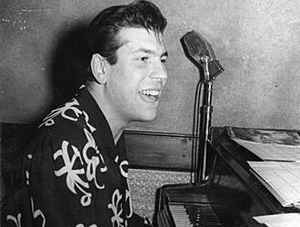 Bruno Martino Source: Radio Italia |
|
| Born Victoria de los Ángeles
López García in
a lodge at the University of Barcelona to a university caretaker,
Victoria de los Angeles
was foreign to the flamenco of her native country,
Spain, she an opera singer. But Barcelona wasn't
really gypsy territory, flamenco having its origins in Andalusia. Madrid, a
few hundred miles north of flamenco's origins, eventually became
a flamenco hub. Barcelona, however, was otherwise the most stylish place to
live in
Spain. It was Spain's jazz hub for American musicians on tour in Europe, and
had for centuries been host to classical music while Islam further south
remained busy either avoiding or banning Western
influences. The rise of flamenco in Spain
is largely due that much of the Iberian peninsula had simply been largely
out of bounds to classical composers and musicians. De los Angeles, however,
was a soprano who had the Barcelona Conservatory from which to graduate in
1941 under the tutelage of arranger and guitarist, Graciano Tarrago. Her
oublic debut was the same year as Mimi in Puccini's 'La Boheme' at the Gran
Teatre del Liceu. She is thought to have made her professional debut there
as well, as the Countess in Mozart's 'The Marriage of Figaro' in 1945. The
earliest recordings of which we know by de los Angelese were in May of 1947
for EMI, interpreting compositions by Joaquin Turina in Barcelona with
Agrupacion de Camera de Barcelona: 'Saeta en forma de salve a la Virgen de
la Esperanza' (Op 60) and 'Poema en Forma de Canciones' (Op 19: 1-5). In May
of 1949 de los Angeles recorded works in London by Turina with Walter
Susskind, as well as 'Triptico' (Op 45) with pianist, Gerald Moore. She
recorded a couple works by Respighi with Gerald Moore that May as well ('Stornellatrice'
and 'E se un giorno tornasse'). Walter Susskind also recorded Mozart's 'Porgi
Amor' with de los Angeles in May of 1949. In March of 1950 she recorded a
couple works by Wagner ('Dich, Teure Halle' and 'Einsam in Truben Tagen').
That March also saw Eduardo Toldra's 'Madre, unos ojuelos vi' recorded with
Gerald Moore. Recordings with Moore in June of 1950 yielded 'El retrato de
Isabela' and 'El Amor y los Ojos', compositions by Amadeo Vives. The next
September de los Angeles stepped away from opera to record 18 tracks of
traditional songs with guitarists, Graciano and Renata Tarrago, all arranged
by Graciano. Tours in the fifties saw to de los Angeles' international fame,
she performing at Carnegie Hall and with the Metropolitan Opera in the US in
1951. She would work with the Metropolitan another decade. She began
visiting Buenos Aires, Argentina, in 1952, becoming a big deal there as well
as in Europe. Her career largely consisted of recitals en concert, she also
notable for her recordings of opera. De los Angeles died the 15th of January, 2005
[obits: 1,
2,
3,
4,
5].
References encyclopedic 1,
2;
musical: 1,
2,
3.
Chronology.
Catalogs: 1,
2,
3,
4,
5.
IA.
Biblio: 'Les introuvables de Victoria de los Angeles' (L'Avant-scène 1985)
*;
'Victoria de Los Angeles' by Peter Roberts (Weidenfeld & Nicolson 1982)
*.
Other Latin classical, such as
Andrés Segovia,
are listed in that section. Victoria de los Angeles 1949 Piano: Gerald Moore Composition: Granados/Periquet With Walter Susskind Composition: Joaquín Turina Victoria de los Angeles 1950 Composition: Wagner Composition: Wagner Composition: Enrique Granados Composition: Handel Victoria de los Angeles 1954 With Giuseppe di Stefano Composition: Giacomo Puccini Victoria de los Angeles 1956 With Jussi Björling Composition: Puccini Victoria de los Angeles 1958 Composition: Bizet Victoria de los Angeles 1959 Composition: Mozart Composer: Giacomo Puccini Victoria de los Angeles 1960 Film excerpt Victoria de los Angeles 1962 Composition: Rossini BBC Television broadcast Victoria de los Angeles 1967 Television broadcast Victoria de los Angeles 1972 Piano: Miguel Zanetti Compositions: Lorca Victoria de los Angeles 1989 Piano: Manuel Garcia Morante Composition: Eduard Toldrà Victoria de los Angeles 1992 Cello: Lluis Claret Filmed live 1992 Olympics Victoria de los Angeles 1994 Live in Aberdeen
|
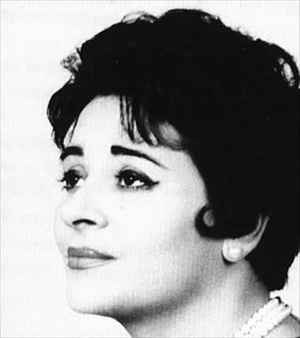 Victoria de los Angeles Source: All Music |
|
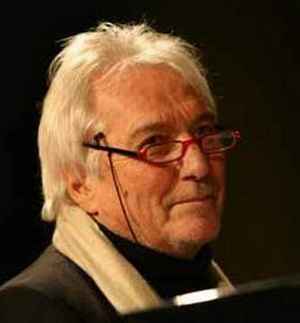 Enrico Intra Photo: Enrico Intra Esta Source: Jazz Italia |
Born in Milan, Italy, 1935, composer and pianist, Enrico Intra,
wasn't (isn't) well-known in the United States. Much of his career was spent
organizing music festivals. He also worked for Italian television and
composed film scores. Intra's education was classical at the Milan
Observatory, but he began his professional career in jazz at age twenty w
his X Quartet. Lord and JDP have traced the X Quintet to as early as April
of '55 in Milan w a crew of Franco Caldironi (vibes), Piero Virdis (guitar),
Al King (bass) and Gianni Vailati (drums) putting away titles like
'Nightingale', 'O Sole Mio', 'Ciliegi Rosa', and 'Ritmo Affascinante', et
al. No release dates are identified for HMV HN3462 and HMV HN3504 but 1955
is a reasonable guess. The next year in '56 Intra was in the Quintetto Jazz
Di Ceglie for titles in May and June like 'Pennies from Heaven' (Parlophone
TT9894) and 'Hallelujah' Parlophone TT9893. In 1957 Intra issued the four-track album, 'Trio'. His appearance at
the third Sanremo Jazz Festival in 1958 was recorded and issued that year.
The next year he opened Intra's Derby Club, a nightclub in Milan presenting
avant-garde fare. That would become a hub not only for touring jazz
musicians but politicians and crime figures alike until its doors closed
in 1985. Lord shows Intra recording w guitarist,
Franco Cerri, as early as 1 September
of 1962 in Rome w the Italian All Stars and Lilian Terry at vocals on 'Tune Up' (Ricordi
MRJ8008) and 'Misty' (Ricordi MRJ8005). Vibraphonist, Milt Jackson,
toured to Italy in 1964 where in Milan he sang vocals backed by Intra's
ensemble released on 'Milt Jackson Sings' (Festival FLD3385). A decade later
in '75 Intra hosted visiting
Gerry Mulligan where in Milan they
recorded 'Gerry Mulligan Meets Enrico Intra' (Produttori Associati
6.22662 AS). Come May of '81 for Intra's tribute to
Bill Evans in a trio w
Cerri and Lucio
Terzano (bass) toward 'Omaggio a Bill Evans' (Dire FO 361).
'Effeto Alfa' went down including Cerri
and Ernesto Verardi at guitars in '82 w the Orchestra Sinfonica Di Milano. Discogs has Intra good for above
thirty albums as a leader or
co-leader. Notable in '94 was 'Nosferatu Live' performed at the Iseo Jazz
Festival on 7 August 1993 w drummer, Paolo Pellegatti. September 26 of '97
witnessed Intra w
Cerri
in a quintet toward their joint album 'From Milan to Brussels' (Sabena
CDPM115).
Cerri
and Intra last performed together per Lord on 15 March of 2007 in
Rome w Marco Vaggi (bass) and Tony Arco (drums) toward 'Double Trio' (Casa
del Jazz CdJ2-09). Come Franco Ambrosetti on trumpet in 2009 toward 'Live in
Milan' (Albore Jazz ALBCD-006). Intra issued 'Incipit', a suite of jazz standards, in 2015.
'Nicola Calgari Quartet featuring Enrico Intra' saw issue in Jan of 2016
followed by 'Three Generations w Mattia Cigalini (sax) and Paolino Dalla
Porta (double bass). Intra is yet active as of this writing in September
2019. References:
1,
2. Discos: 1,
2,
3, Lord (leading 23 of 55 sessions).
Facebook. Enrico Intra 1958 III Festival Del Jazz Sanremo Bass: Ernesto Villa Drums: Pupo De Luca Composition: Enrico Intra Enrico Intra 1962 From 'Jazz in Studio' Bass: Pallino Salonia Drums: Pupo De Luca Composition: Miles Davis Composition: Enrico Intra Enrico Intra 1964 Music: Joseph Kosma 1945 Lyrics French: Jacques Prévert Lyrics English: Johnny Mercer Album: 'Milt Jackson Sings' Enrico Intra 1968 Backing Jacinta Composition: Enrico Intra/Vito Pallavicini Arrangement: Francesc Burrull LP: 'Jacinta: I San Remo 68' Enrico Intra 1969 Music: Enrico Intra Soundtrack Enrico Intra 1970 All comps by Ennio Franco Celant Enrico Intra 1975 Composition: Enrico Intra Enrico Intra 1976 From 'Gerry Mulligan Meets Enrico': Composition: Enrico Intra Composition: Enrico Intra Composition: Gerry Mulligan Enrico Intra 2007 Filmed live Enrico Intra 2009 Filmed live Composition: Carlo Alberto Rossi Giorgio Calabrese Enrico Intra 2010 Filmed live Enrico Intra 2015 From 'Incipit': Composition: Gershwin Brothers 1938 For the movie 'The Goldwyn Follies' Music: Vincent Youmans 1924 Lyrics: Irving Caesar
|
|
|
Tete Montoliu
was born blind in Barcelona, Spain, in 1933. Montoliu's talent placed him an important role as host
to American musicians on tour to Europe, drawing them south of the Pyrenees. Beyond his earliest years in the
music profession in the fifties Montoliu picked up American jazz so
proficiently as to become a magnet for American performers, thereat
including Catalonia on their itineraries. Montoliu studied piano as a child,
later at the Conservatori Superior de Música de Barcelona. His first
recordings took place in Netherlands in 1954, though those tracks weren't
released by Philips on a 7" EP until 1958: 'Píntame De Colores Pa Que Me
Llamen Superman' and 'No, No y No'. He recorded several more tracks in
Barcelona in May of '55 with Lorenzo González which went unreleased until
2006. Perez-Fitzgerald [Discos 7 below] lend a date of January 1st of 1956
for the issue of eight titles on four Columbia 78s: '¡Qué Cosas..., Qué Cosas!'/'No
Me Hagas Cosquillitas', 'Ayer No Viniste'/'Playa Escondida', 'Cha Cha Chá
Chabela'/'Eso Es El Amor' and 'La Mujer Vespa'/'Chocolate O Café'. He was
working bars in Barcelona three months later when all that thrust shot him
into a whole new universe unforeseen upon Lionel
Hampton coming to town and hiring him to join his tour of Europe that
March. Latin rhythms got left behind as Montoliu focused on the North
American sound. He took a trip to New York City in 1967 where he recorded
unknown titles w
Richard Davis (bass) and
Elvin Jones (drums) at Top of
the Gate (2nd story above the Village Gate), tapes lost. Montoliu held a
poor opinion of free jazz but backed
Anthony Braxton on
'In the Tradition' Vol 1 & 2 in 1974 as those addressed jazz standards like
'Just Friends' and 'Body and Soul' w a bit of bebop per 'Ornithology'.
Another trip to the States in 1979, now Los Angeles, resulted in Montoliu's
LP, 'Lunch in L.A.', a suite of solos excepting
Chick Corea contributing to
Larry Spear's composition, 'Put Your Little Foot Right Out'. Along w backing
other musicians Montoliu issued well over fifty albums, 5 recorded for
Steeplechase in 1980 alone: 'Boston Concert', 'I Wanna Talk About You' and
'Catalonia Nights' Vol 1-3. Highlighting the nineties was his release of
'The Man from Barcelona' in 1991 w
George Mraz (bass) and
drummer, Lewis Nash. Among other musicians significant to Montoliu's career were
Dexter Gordon (7 albums) and
Ben Webster (3 albums). Though Montoliu
visited the States on multiple occasions the larger portion of his touring
and recording was in Europe, preferring overall to keep to Barcelona where
he was a key figure in making that city a requisite
destination for American jazz musicians. Montoliu died in Barcelona on 24
August 1997 [obit]. References:
1,
2,
3.
Sessions: Agustín Pérez-Michael Fitzgerald: main,
multiple versions,
personnel; Tom Lord (leading 79 of 131).
Discos: 1,
2,
3,
4,
5,
6,
7.
IMDb. Tete Montoliu 1956 Composition: Jose Sole Composition: Pepe Iglesias Composition: Sixta Batista Mana Tete Montoliu 1958 Recorded in Netherlands 1954 Composition: Osvaldo Farresa Tete Montoliu 1962 Filmed live Composition: Vernon Duke/John Latouche Tete Montoliu 1963 Trumpet: Kenny Dorham Composition: Dorham Tete Montoliu 1964 Filmed live with Dexter Gordon Composition: Gerald Valentine/Billy Eckstine Tete Montoliu 1973 Album: 'Temas Latinoamericanos' Tete Montoliu 1974 Composition: John Coltrane Album: 'Tete!' Album Acoustic piano: Jordi Sabates Electric piano: Tete Montoliu All comps by Jordi Sabates Tete Montoliu 1981 Filmed live with Sonny Stitt Composition: Roger Ram Ramirez Jimmy Davis/Jimmy Sherman ('Gravy') Filmed live with Sonny Stitt Composition: Jimmy Mundy Gene Ammons Richard Carpenter Tete Montoliu 1995 Compositions: Thelonious Monk
|
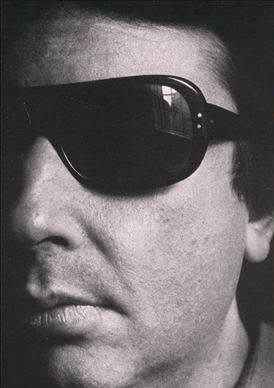 Tete Montoliu Source: All Music |
|
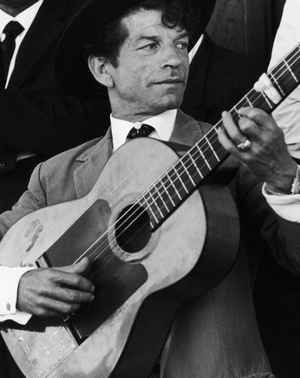 Manitas de Plata Source: Carlos Bonell |
Born Ricardo Baliardo in 1921 in a gypsy caravan in Sète,
France,
Manitas de Plata
[*], examples the enormous popularity of flamenco
during the seventies and thereafter, De Plata to style rustic flamenco into a
vehicle of superstardom despite critical appraisals of his oeuvre as not
proper flamenco. He drew attention
as he played guitar each year during the gypsy pilgrimage to the shrine of Saintes-Maries-de-la-Mer in Camargue, France. It was there that he was
recorded by Deben Bhattacharya, to turn up on an album by various artists
released by Disques Vogue in 1960: 'Pelerinage Gitan aux Saintes Maries de la
Mer'. An interesting story of De Plata's next recordings with
flamenco singer, Jose Reyes
[*], in 1961 is told by
Vincent Sheean.
Unless they were rerecorded a few of those tracks ('Seguiriyas', 'Saeta' and
'Fandangos') ended up on De Plata's debut album in 1963: 'Juerga!'
(Connoisseur Society CS 2003). Reyes was one of De Plata's more important
musical associates for years to come, particularly in terms of rumba flamenca, also called
gypsy or Spanish rumba. Their relationship would also lead to the formation
of the later Gipsy Kings, a highly popular rumba flamenca group that would
consist of De Plata's three sons, Tonino,
Jacques and Maurice, and Reyes' five sons, Nicolas, André, Canut, Paul and
Patchaï. The Gipsy Kings (in which neither father, Jose or Manitas, was a
member) issued their first album, 'Allegria', in 1982. Returning to De
Plata, IMDb has him acting in the
first of a few French films per the premiere of 'Where Are You From, Johnny?'
on 30 Oct 1963 in which he assumed an uncredited role as a gypsy guitarist.
He
first visited the United States in 1965 to play at Carnegie Hall, but his
name was little recognized until 'Juerga!'s reissue there in 1967. IMDb
traces his first of numerous television appearances throughout his career
into the new millennium per an episode of 'Something Special' aired on 22
Feb of 1967 from Los Angeles. De Plata's then became a life of touring the
globe, giving 150 concerts a year during his heydays in the seventies. De
Plata recorded over eighty flamenco albums that made him a
multi-millionaire, selling some 93 million. He didn't die broke, but spent
most of it living rich, drawn to casinos and expensive automobiles. Having played at London's Royal Albert Hall eleven times,
De Plata
died on 5 November 2014 in Montpellier, France [obits: 1,
2,
3,
4].
Discos: 1,
2,
3.
IMDb.
Compilations: 'Feria Gitane' 1988 (compositions by Plata) *;
'The Gipsy Legend' (9 albums 1963-68): 1,
2
Facebook tribute.
Discussion: 1,
2. References for the Gipsy Kings (in
which neither De Plata
nor Jose Reyes were members though fathers to its personnel): 1,
2,
3,
4,
5,
6.
Discos: 1,
2,
3,
4. Manitas de Plata 1965 From 'Flamenco Guitar' Debut LP Recorded Oct 1963 Arles, France Comps below by Plata Manitas de Plata 1967 Album: 'Flamenco Magic' All comps by De Plata Filmed live With Salvador Dali & Jose Reyes Manitas de Plata 1968 Filmed live Live in Saintes Maries de la Mer Filmed live Album: 'The Art of the Guitar' All comps by De Plata Manitas de Plata 1975 Filmed concert Manitas de Plata 1986 Filmed concert Manitas de Plata 1988 Film Composition: Manitas de Plata
|
|
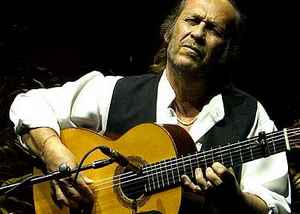 Paco de Lucia Source: Quora |
Born Francisco Gustavo Sánchez Gomez in 1947 in Algeciras,
Andalucía, Spanish flamenco guitarist,
Paco de Lucía, was groomed by his
father to be a professional guitarist in the fashion of Niño Ricardo. Howsoever, de
Lucia would combine elements including a touch of jazz to flamenco that drew
a demarcation between traditional and modern flamenco: nuevo flamenco,
comparable to the demarcation between old folk and new folk in the United
States w Bob
Dylan. Beginning at age five, it's said de
Lucia was made to practice not one, but twelve hours, each day. De
Lucia's debut issues were in 1961 (age fourteen), releasing three 7" volumes
titled 'Los Chiquitos De Algeciras' ('The Kids of Algeciras') as Paquito Sánchez with his brother,
Pepito Sánchez. He toured with flamenco dancer, Jose Greco, until arriving
in the States in 1963. De Lucia released his first album, 'Dos Guitarras
Flamencas', in 1964 with guitarist, Ricardo Modrego. His next was issued the
following year, which pace of production de Lucia largely kept into the
eighties as he toured internationally. Among his first albums with his
brother, Ramón de Algeciras, was 'Canciones Andaluzas Para 2 Guitarras',
released in 1967. He also fused flamenco w jazz that year w tenor
saxophonist, Pedro Iturralde, per '¡Jazz Flamenco!' (Hispavox HH 11-128). While touring in Europe with the group, Festival Flamenco
Gitano, de Lucia met singer,
de la Isla, in 1968, recording ten
albums with him into the latter seventies. De Lucia made his first
television appearance in 1976 with the BBC, performing on 'Parkinson'. It
was 1979 when de Lucia formed the Guitar Trio with Al Di Meola and
John McLaughlin, to dissolve in
'83 though a reunion album, 'The Guitar Trio', was later released in 1996.
In 1981 he formed the Paco de Lucía Sextet with brothers, Pepe and Ramón,
three albums resulting from that ensemble. De Lucia first performed in the
Soviet Union in 1987. He released more than 35 albums as a leader or
collaborator, also appearing on a host of recordings as a sideman. He
appeared on several albums with both Fosforito and Tomatito. Into the new
millennium de Lucia took flamenco to places such as Croatia, Turkey, Morocco
and Tunisia. Prior to that he had been the recipient of two honorary
doctorates, one from the University of Cadiz in 2007, another from the
Berklee College of Music in Boston in 2010. De Lucía died of heart attack on
25 February 2014 while vacationing with his family in Mexico. He was buried in
Algeciras, Andalusia [obits: 1,
2,
3,
4,
5,
6].
References: 1,
2,
3,
4,
5.
Discos: 1,
2,
3,
4,
5,
6, Lord (leading 5 of 27 sessions jazz only).
IMDb.
Documentaries: 'Francisco Sánchez: Paco de Lucía' directed by Daniel Hernández 2002.
IA.
Javier Primo interview 2001.
Instruction.
Discussion.
Further reading: El Pais;
RTVE.
Biblio: 'Paco de Lucía' by Diana Pérez Custodio (Servicio Publicaciones 2005);
'Paco de Lucía and Family: The Master Plan' by D. E. Pohren (Society of Spanish Studies 1992);
'Paco de Lucia: My Memories of a Flamenco Legend' by Rusel DeMaria (Waterfront Digital Press 2014).
Other profiles: 1,
2,
3,
4,
5. Paco de Lucia 1961 Flamenco traditional Tiento(s) y tanguillo(s) de Cadiz Album: 'Los Chiquitos de Algeciras Vol 3' ('I'm Not Afraid of Death Today') Flamenco traditional Canton por solea [1, 2] de Alcalá English lyrics Album: 'Los Chiquitos de Algeciras Vol 2' Note: Titles above, Lucia age 14, were released w Lucia going by Paquito Sánchez at guitar and Pepito Sanchez on vocals. in 1963 Lucia released the same titles (same or alt versions unknown) on 'Cante Flamenco Tradicional' Hispavox HH 10-218 w Lucia going by Paco De Algeciras at guitar and Pepe De Algeciras on vocals. Paco de Lucía 1964 Album w Ricardo Modrego Paco de Lucía 1967 La Fabulosa Guitarra de Paco de Lucía Album Suite of solos Paco de Lucía 1973 Album w Ramón de Algeciras All comps: Lucia/José Torregrosa Paco de Lucía 1976 Album w Ramón de Algeciras Bass guitar: Álvaro Yebenes Percussion: Pedro Ruy-Blas All comps by Lucia Filmed live Composition: Lucia Paco de Lucía 1978 Filmed live Paco de Lucía 1981 Belgian television Solo Belgian television With Ramon de Algeciras Composition: Lucia The Guitar Trio With Al Di Meola & John McLaughlin Composition: John McLaughlin Paco de Lucía 1991 Filmed live Paco de Lucía 1996 The Guitar Trio Reunion With Al Di Meola & John McLaughlin Composition: Al Di Miola Paco de Lucía 2004 Filmed live w Nuno Josele Filmed live Composition: Lucia
|
|
|
Enrico Rava See
Enrico Rava. |
||
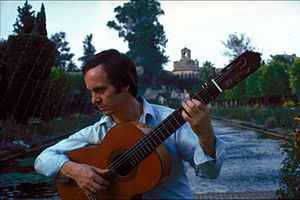 Paco Pena 1984 Source: Wikipedia |
Born in 1942 in Córdoba, Spain, traditional flamenco guitarist
w style,
Paco Pena, took up his axe at age six,
was playing professionally at age twelve. A government program sponsoring
folk dance and music saw Pena touring Spain before signing up with
commercial companies to back flamenco dance in Madrid and Costa Brava. In
1966 one of those dancers, El Sali, issued an album titled 'Flamenco! El
Sali and his Ballet Espagnol' on which Pena plays guitar. Pena next took his
bag of tricks to London. He there made his solo debut at Wigmore Hall in
1967. Some bright impresario got Pena billed with a very different sort of
guitarist who drew an audience,
Jimi Hendrix, and some kids got introduced
to one of the 20th century's finest guitarists before zoning in on LSD. From
there it was the United States and Carnegie Hall. His debut album, 'The
Incredible Paco Peña', was issued in 1968. 'Toques Flamencos' saw release in
1976, along w a book of transcriptions by the same title (New Services). In 1981 Pena was
instrumental to the founding of the Cordova Guitar Festival. In 1985 Rotterdam
University in Amsterdam created a department for the first formal teaching
of flamenco, with Pena at the chalkboard. Such remarks on the exclusivity of
flamenco. It had been about some hundred and thirty years, passed from
musician to musician without a school, and now it was going to be played by
others who were neither gypsies nor Spaniards, but could afford a college
education. Unlike Latin music in Brazil, the
Caribbean or Mexico where foreign rhythms were welcome (like jazz), flamenco has ever been a highly guarded genre as the
national music of Spain, being both folk and select. Fusions with other genres like jazz or classical
have been few and exceptional per occasion, such as those between flamenco
guitarists, Camarón de la Isla
and
Paco de Lucía with
Al Di Meola and
John McLaughlin. It's true:
flamenco guitarists pop right from the oven equipped with guitars. They see less messing with than Texas.
Classical guitarist, John
Williams, might have discovered that when he and Pena met in 1969. During
the seventies they developed a relationship w the Chilean band, the
Inti-Illimani, with whom they performed whenever the
Inti-Illimani
toured to Great Britain. Those occasions finally led to the album,
'Fragments of a Dream', released in 1986, with Williams stepping out of
classical, and Pena out of flamenco, to deliver to some compositions by
Chilean
Inti-Illimani director, Horacio
Salinas. Pena issued his book of transcriptions, 'Toques Flamencos', in
1992, that containing 10 pieces from his album by the same name released
back in 1976 per above. Into the new millennium, Pena joined classical
guitarist, Eliot Fisk, in 2006 toward the 2014 issue of 'Paco Peña & Eliot
Fisk in Duo Recital' [1,
2]. Pena began touring with the theatrical, 'Quimeras', in 2010. His
latest release, 'Quimeras', in 2013 is a contrast fusion of flamenco with
rhythms out of North Africa: Guinea and Senegal. Pena is yet active with
residences in both London and Cordoba where none have yet dared, so far as
known, to step into a dusty street to rattle spurs against the 'High
Noon' marshal of flamenco guitar. References: 1,
2,
3,
4.
Discos: 1,
2,
3,
4,
5.
Books by Pena.
Tributes
by Pena to
Paco de Lucía.
Interviews: Robert Moss 1995; Angus McPherson
2017.
Discussion. Paco Pena Filmed live Composition: Pena Paco Pena 1975 Duet with John Williams Television broadcast Television broadcast Paco Pena 1976 Album: 'Toques Flamencos' Album: 'Toques Flamencos' Television broadcast: 'The Five Faces of the Guitar' Composition: Pena Paco Pena 2013 Filmed live Paco Pena 2014 Duets with Eliot Fisk
|
|
|
Born in 1942 in Granada, Spain, flamenco vocalist and
composer,
Enrique Morente, was
a teenager when he headed for Madrid to become a professional singer in
flamenco clubs. In 1964 he sacked employment with the Ballet de Marienma
which found him touring to New York City at the World's Fair and Washington
DC at the Spanish Embassy. He afterward continued working with dance
companies, touring Europe and Japan, as well as performing in tablaos (flamenco
venues) in Madrid. Morente's first recordings went toward the album, 'Cante Flamenco', in 1967
with guitarist, Félix de Utrera. 'Cantes antiguos del flamenco' followed in
1969 with guitarist, Niño Ricardo. Such were traditional flamencos. If
Antonio Mairena was both popular and
criticized for his pursuit of traditional gypsy flamenco, Morente was
something the inversion of that, introducing innovations that purists found
hard to swallow. Such forays began with his 1971 album: 'Homenaje flamenco a
Miguel Hernández' ('Flamenco Homage to Miguel Hernández'), on which flamenco
lyrics were exchanged for poetry by Miguel Hernández. Come his recital, 'Flamanco:
Nueva Era', w
guitarist,
Manolo Sanlúcar, at
the Colegio Menor de la Juventud en Jerez on 7 July 1972
[*]. During the seventies Morente toured Mexico and the
United States before releasing another homage in
1977, this time to folk (flamenco) vocalist, Antonio Chacón:
'Homenaje a Don Antonio Chacón' (Homage to
Antonio Chacón). Such was a return to orthodox flamenco before he began
innovating again in 1978 with 'Despegando' ('Taking Off'). His next return
to traditional flamenco was in 1990 on 'Morente-Sabicas', the year that
guitarist (Sabicas) died. The next year he
released the LP, 'Misa Flamenca', complete with Gregorian chants. (There had
been earlier combinations of flamenco with the Catholic Mass.) In 1996 Morente
caused a disturbance by combining flamenco with rock
on the issue of
'Omega' [*] with the British band, Lagartija Nick, that gone down on 23 July in
Granada [Discogs]. Into
the new millennium 'Enrique Morente en la Casa
Museo de García Lorca de Fuentevaqueros' was issued in 2001, an album
addressing the poetry of Federico García Lorca. Morente merged flamenco with
punk rock during an encore performance by Sonic Youth at Heineken Greenspace
in Valencia on 28 October 2005 [1,
2,
3]. 'Pablo de Málaga',
addressing the poetry of Pablo Picasso, appeared in 2008. In 2010 Morente
was hospitalized for an ulcer, a coma ensuing that found him brain dead on
13
December [obits: 1,
2,
3,
4,
5].
Morente is survived by his daughter, flamenco singer, Estrella Morente [1,
2],
born in 1980 in Las Gabias, Granada, to dancer, Aurora Carbonell.
References: 1,
2,
3,
4.
Discos: 1,
2,
3,
4,
5.
IBDb.
Further reading: Angel Romero;
Claude Worms (analysis: composition).
Other profiles: 1,
2. Enrique Morente 1967 Composition: Mirabras Album: 'Cante Flamenco' Enrique Morente 1969 ('You Came in a Dream') Music: Enrique Morente Lyrics: Al Mutamid Enrique Morente 1975 Composition: Enrique Morente Album: 'Se hace camino al andar' Enrique Morente 1980 Filmed live With members of Guadalquivir, et al Enrique Morente 1989 Music: Enrique Morente Text: Federico Garcia Lorca Enrique Morente 1995 Filmed live with Juan Habichuela Guitar: Juan Habichuela Compás al golpe: Antonio Carmona Enrique Morente 1996 Album with Lagartija Nick Enrique Morente 1998 Music: Enrique Morente Text: Federico Garcia Lorca Album: 'Morente: Lorca' Enrique Morente 1999 Live with Lagartija Nick Music: Enrique Morente/Lagartija Nick Text: Federico Garcia Lorca Enrique Morente 2005 Filmed live w Sonic Youth Heineken Greenspace, Valencia Oct 28 2005 Composition: Enrique Morente Enrique Morente 2006 Festival de Jazz de Vitoria-Gazteiz Filmed concert Enrique Morente 2008 Composition: Popular/Enrique Morente Album: 'Pablo de Málaga' Enrique Morente 2010 Filmed live
|
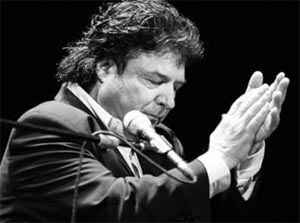 Enrique Morente Source: Flamenco Gypsy |
|
|
Camarón de la Isla was a flamenco
guitarist who released his debut album at the age of nineteen w
Paco de Lucía, the latter famous for his Guitar Trio
with Al Di Meola and
John McLaughlin. Born José Monge Cruz in 1950 in San Fernando, Cádiz, Spanish flamenco
singer, Cameron was the son
of a blacksmith and basket weaver. He picked up the name, Cameron (Shrimp)
because he was blond and fair in complexion. De la Isla began singing for
money at bus stops and inns at age eight. He left for Madrid in 1968 where
he held a residency at the Tablao Torres Bermejas (restaurant and flamenco
venue) for twelve years. In 1968 he turned up on an album by Antonio Arenas,
'Flamencos Aus Dem Sonnigen Spanien', on one track, 'Bulerias
Gitanas'. De la Isla released his first album in 1969 with
guitarist, Paco de Lucía, 'Al Verte las Flores Lloran'
[reissue 2005],
most titles written by himself.
That album together with the next four with
de Lucía were issued minus titles,
they known by the titles of their first tracks. His first of several albums
with guitarist, Tomatito [1,
2,
3], 'Como el Agua' [*] arrived in 1981 w
Lucía. In 1989 de la
Isla recorded 'Soy Gitano' [*] with the Royal Philharmonic Orchestra, that the
first album to achieve gold status (50,000 copies) in Spain. His final
recordings are thought to be those on 'Camarón – Potro De Rabia Y Miel'
[*],
released in 1992. He died of lung cancer in Badalona, Spain, that year,
above 100,000 people said to attend his funeral
[obits: 1,
2].
References: 1,
2,
3,
4,
5.
Discos: 1,
2,
3,
4.
IMDb.
Reviews.
Documentary: 'Camarón: Flamenco y Revolución' ('Camerón: The Film' US) directed by Alexis Morante 2018
*.
IA.
Further reading: Felix Contreras;
Bryan Hemming.
Bibliography: 'Composition ... Flamenco ... Present' by Peter Manuel (CUNY 2010);
'Camarón de la Isla: El Dolor de un Principe' by Francisco Peregil (Aguilar 1993). Camarón de la Isla 1968 Album: 'Flamencos Aus Dem Sonnigen Spanien' Camarón de la Isla 1969 Lyrics: José Monge Album: 'Al Verte las Flores Lloran' With Paco de Lucía Lyrics: José Monge Album: 'Al Verte las Flores Lloran' With Paco de Lucía Camarón de la Isla 1972 Composition: Antonio Sánchez/Paco De Lucia Album: 'Canastera' With Paco de Lucía Camarón de la Isla 1978 With Tomatito Composition: Camarón de la Isla 1990 Filmed live with Tomatito Camarón de la Isla 1991 Filmed live at the Festival de Montreux Lyrics: José Fernández Torres José Monge Cruz Vicente Amigo
|
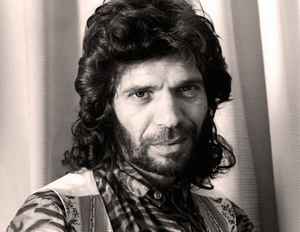 Camarón de la Isla Source: Radiole |
|
|
Born Manuel Muñoz Alcón in November 1943 in Cadiz, Spanish flamenco guitarist,
Manolo Sanlúcar, was trained by his
father, a baker who played guitar. As the folk music of Spain flamenco is a genre
distinct to itself, fusions with other styles uncommon, such as
Paco de Lucía mixing
flamenco with jazz musicians like Al Di Miola or
Enrique Morente combining
flamenco with rock in the nineties. Sanlucar did neither of those, his a classical lean.
Combining flamenco with orchestra, Sanlucar would fit aptly into the
classical section of these histories under Flavors, the more so as his
career progressed. In so doing, Sanlucar brought rustic gypsy flamenco into
the posh. In the meantime, as a latter entry on this page Sanlucar helps
wrap up clarification of the various styles of flamenco, that the address of
his first several albums. Sanlucar began performing professionally at age
thirteen ('57) with flamenco vocalist,
Pepe Marchena. Sanlucar worked as a
sideman before the release of his first name album, 'Recital Flamenco'
[*],
in 1968, that addressing various forms of flamenco via titles composed by
himself. Unfortunately CERN is required to find those sessions so we give
1968 as his only known earliest vinyl. In 1971-73 Sanlucar released three volumes
of 'Mundo y Formas de la Guitarra Flamenca', exampling numerous forms of
flamenco, titles written by himself [1,
2,
3].
Among future albums came 'Sanlucar' in 1974 w most titles composed by
himself [1975: Discogs/ RYM] His composition, 'Alfarero', saw issue
on 'Sentimiento' [*]
in 1976, the same year his 'Fantasia para Guitarra y Orquesta' premiered at
the Teatro Real (Royal Theatre) [*]
in Madrid. The album, 'Fantasia para Guitarra y Orquesta'
[*],
arrived in 1978 w titles authored by himself, orchestration by Ricardo
Miralles. In 1984 Sanlucar recorded 'Trebujena', a concerto for guitar and
orchestra, the same year his flamenco ballet, 'Medea', premiered on 13 July
at Madrid's Teatro de la Zarzuela [*/
other sources other years] w the Ballet Nacional de España. Manuel
Ruiz at ABC Sanlucar recording the album, 'Medea'
[1,
2,
3],
the same month, that to emerge in 1987 w direction of the Orquesta
Filarmónica de Málaga by
Alexander Rahbari. 'Medea' is a very rare album nowhere found except in a
2011 compilation shared w 'Tauromagia'
[1,
2,
3],
Sanlucar's album w bullfighting its theme issued in '88. (Sanlucar's 'Medea'
witnessed reinterpretation by guitarist, Manuel Barrueco, in 2013, winning a
Latin Grammy for Best Classical Album.) December
of 1988 saw the issue of 'Solea', another work for the National Ballet of Spain. Sanlucar's
symphony, 'Reservoir', premiered in Malaga in 1992. Also that year he was
featured in the Carlos Saura film, 'Sevillanas'. Sanlucar's latest studio
album, 'Locura de Brisa y Trino' [1,
2], was released in 2000 featuring vocalist,
Carmen Linaris. In 2009 his 'Music for Eight Monuments' premiered,
originally commissioned in 1991 by the government of Andalucia. Francesc
Serracanta has Sanlucar announcing his retirement from staged concerts on 27 July, 2013 after a
performance of 'Himno de Andalucía' at the Cueva de Nerja [1,
2,
3]
in Malaga. (The 'Himno de Andalucia' ['Anthem of Andalucia'] was composed by
José del Castillo Díaz with lyrics by Blas Infante. It premiered in 1936 at
the Alameda de Hércules [*] in Seville a week before the beginning of the Spanish Civil War, the
latter on 17 July [*]
toward the establishment of the Franco regime.)
Sanlucar ceased giving concerts in order to more concentrate, as a principle
interpreter of flamenco, on an audiovisual project
begun in 2010, ‘La Guitarra Flamenca’, a documentary of flamenco guitar which premiered in 2016 at the
Picasso Museum in Malaga per the Festival de Cine Español
[*].
Sanlucar is yet active, though experiencing various ailments of old
age, he approaching 76 years as of this writing. References: 1,
2,
3,
4.
Discos: 1,
2,
3,
4,
5.
IMDb.
IA.
Transcriptions: 1,
2.
Pepe Oliva interview 2016.
Further reading: Manuel Bohórquez,
Jason Webster.
Other profiles: 1,
2,
3,
4.
Manolo Sanlúcar 1968 From 'Recital Flamenco' Album of flamenco styles All comps by Sanlucar Manolo Sanlúcar 1971 Sevillanas de las Cuatro Esquinas Album: 'Mundo y Formas de la Guitarra Flamenca Vol I' Flamenco styles All comps by Sanlucar Manolo Sanlúcar 1975 Sevillanas de las Cuatro Esquinas Album: 'Sanlucar' Manolo Sanlúcar 1987 Album: 'Medea' Orquesta Filarmónica de Málaga Director: Alexander Rahbari See 'Tauromagia - Medea' Manolo Sanlúcar 1988 From 'Tauromagia' All composition Sanlucar Manolo Sanlúcar 1990 Filmed live w Paco de Lucia Composition: Lucia/Sanlucar Manolo Sanlúcar 1991 Filmed live at Montreux Jazz Festival Composition: Sanlucar Manolo Sanlúcar 2000 From 'Locura de Brisa y Trino' Voice: Carmen Linares All music Sanlucar All text Federico García Lorca Manolo Sanlúcar 2009 Festival de la Guitarra de Córdoba With the Orquesta de Cordoba
|
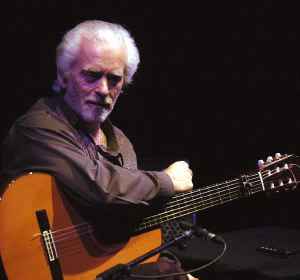 Manolo Sanlucar Source: Membrilla |
|
|
|
We suspend this history of Latin recording in Europe with Manolo Sanlucar. |
|
Early Blues 2: Vocal - Other Instruments
Modern Blues 2: Vocal - Other Instruments
Romantic: Composers born 1770 to 1840
Modern: Composers born 1900 to 1950
Country
Early Jazz 1: Ragtime - Bands - Horn
Early Jazz 2: Ragtime - Other Instrumentation
Modern 4: Guitar - Other String
Modern 5: Percussion - Other Orchestration
Modern 7: Latin Jazz - Latin Recording
Modern 8: United States 1960 - 1970
Modern 9: International 1960 - 1970
Latin
Latin Recording 2: The Caribbean
Latin Recording 3: South America
Total War - Sixties American Rock
Classical - Romantic to Modern
Jazz Early - Ragtime - Swing Jazz
Jazz Modern - Percussion - Song - Other
Latin Recording - The Caribbean - South America
![]()
vfssmail (at) gmaill (dot) com